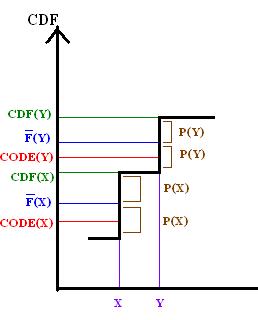Shannon–Fano–Elias coding
In information theory, Shannon–Fano–Elias coding is a precursor to arithmetic coding, in which probabilities are used to determine codewords.[1] It is named for Claude Shannon, Robert Fano, and Peter Elias.
Algorithm description
Given a discrete random variable X of ordered values to be encoded, let be the probability for any x in X. Define a function
Algorithm:
- For each x in X,
- Let Z be the binary expansion of .
- Choose the length of the encoding of x, , to be the integer
- Choose the encoding of x, , be the first most significant bits after the decimal point of Z.
Example
Let X = {A, B, C, D}, with probabilities p = {1/3, 1/4, 1/6, 1/4}.
- For A
- In binary, Z(A) = 0.0010101010...
- code(A) is 001
- For B
- In binary, Z(B) = 0.01110101010101...
- code(B) is 011
- For C
- In binary, Z(C) = 0.101010101010...
- code(C) is 1010
- For D
- In binary, Z(D) = 0.111
- code(D) is 111
Algorithm analysis
Prefix code
Shannon–Fano–Elias coding produces a binary prefix code, allowing for direct decoding.
Let bcode(x) be the rational number formed by adding a decimal point before a binary code. For example, if code(C) = 1010 then bcode(C) = 0.1010. For all x, if no y exists such that
then all the codes form a prefix code.
By comparing F to the CDF of X, this property may be demonstrated graphically for Shannon–Fano–Elias coding.

By definition of L it follows that
And because the bits after L(y) are truncated from F(y) to form code(y), it follows that
thus bcode(y) must be no less than CDF(x).
So the above graph demonstrates that the , therefore the prefix property holds.
Code length
The average code length is .
Thus for H(X), the entropy of the random variable X,
Shannon Fano Elias codes from 1 to 2 extra bits per symbol from X than entropy, so the code is not used in practice.
See also
References
- ^ T. M. Cover and Joy A. Thomas (2006). Elements of information theory (2nd ed.). John Wiley and Sons. pp. 127–128. ISBN 978-0-471-24195-9.
- v
- t
- e
| Entropy type |
|
|---|---|
| Dictionary type | |
| Other types | |
| Hybrid |
| Transform type | |
|---|---|
| Predictive type |
| Concepts | |
|---|---|
| Codec parts |
| Concepts | |
|---|---|
| Methods |
| Concepts | |
|---|---|
| Codec parts |
- Compressed data structures
- Entropy
- Information theory
- Kolmogorov complexity
- Prefix code
- Quantization
- Rate–distortion
- Redundancy
- Symmetry
- Smallest grammar problem
- Hutter Prize
- Global Data Compression Competition
- encode.su
- Matt Mahoney
- Mark Adler
 Compression formats
Compression formats Compression software (codecs)
Compression software (codecs)






























